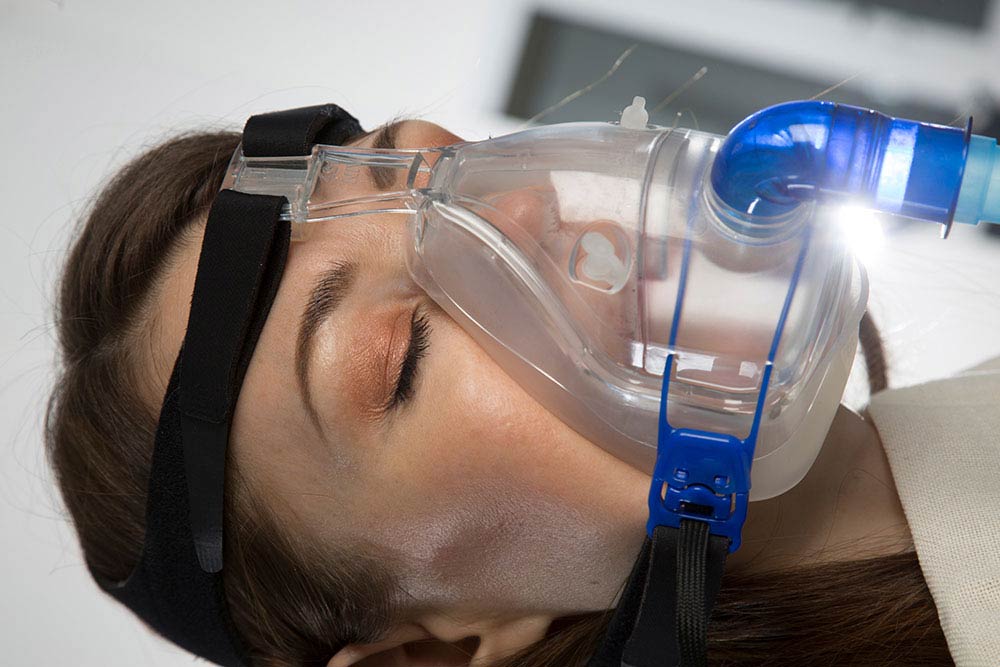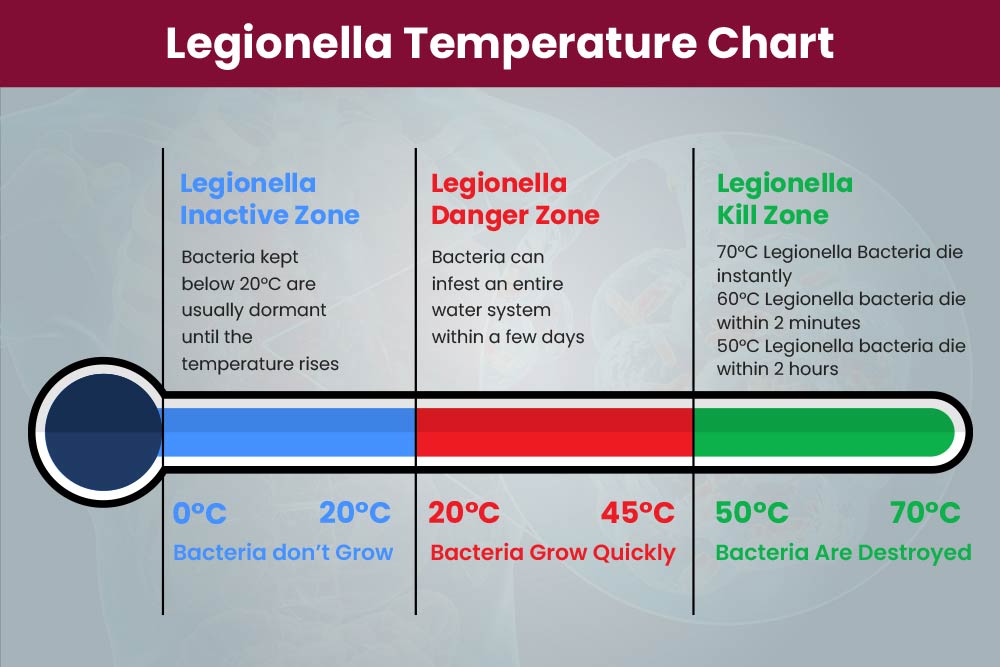
Legionella, the bacteria behind Legionnaires’ disease, thrives in certain conditions. These conditions are routinely found in complex or commercial water systems. Because of this risk, anyone responsible for a water system must know how to protect against Legionella outbreaks.
The first step is understanding what temperature kills Legionella because heat is the best way to kill harmful microbes. But high temperatures aren’t practical or safe for every system.
Suppose you’re responsible for a building or workplace – our guide explains the different risk controls you can use to stop the spread of Legionella bacteria in your water systems.
What is Legionella?
Legionella is a harmful bacteria found naturally in bodies of water. It’s a minor threat in the wild as conditions outdoors rarely allow infection. Swimming in or even drinking contaminated water aren’t significant disease risks. The inhalation of infected water droplets (aerosols) is dangerous, so Legionella is a severe threat in human-made water systems.
Standard features like showers, hot tubs and cooling towers create aerosols, making infection extremely likely if Legionella is in the water supply. Legionella is regularly found in poorly maintained systems since tepid water stored in dirty tanks creates an ideal breeding ground for the bacteria.
That’s why you’ve got to maintain and operate water systems in a way that eliminates or limits Legionella’s growth.
Legionnaires’ Disease
Legionellosis is caused by inhaling Legionella bacteria. Legionellosis is a family of lung diseases with three distinct strains: Lochgoilhead fever, Pontiac fever and the much more severe Legionnaires’ disease.
Legionnaires’ disease is a form of pneumonia and has a similar harmful effect on lung tissue. There’s overlap with symptoms, too, which means Legionnaires’ is sometimes misdiagnosed as common pneumonia.
Muscle aches are usually the first sign of infection, two to three days after exposure to Legionella. This is then quickly followed by:
- A persistent cough
- Shortness of breath for no apparent reason
- Chest pain, particularly when breathing or coughing
- A high temperature or fever (over 40°C)
- Headaches
- Fatigue
- Nausea or vomiting
- Diarrhoea
Antibiotics are always necessary for any bout of Legionnaires’ disease, with some patients needing hospitalisation or even the use of a ventilator to stabilise breathing.

There were 503 reported cases in 2019, according to Public Health England. Some doctors theorise this is below actual figures due to the common confusion with pneumonia. The majority of patients recover, although the disease can be fatal. You’re particularly vulnerable if you:
- Smoke (or have smoked)
- Are over 50 (immune systems naturally weaken as we age)
- Have an underlying lung condition
- Have an inherently weaker immune system (for example, people with diabetes or pregnant women)
There’s no Legionnaires vaccine, so safe water system management is the only way to protect your building’s occupants from infection.
How Can You Manage Legionella Risks?
The first step is to complete a Legionella risk assessment. It’s similar to a conventional risk assessment except you’re looking at your water system to:
- Determine if Legionella growth is possible
- Identify infection hazards
- Evaluate disease risks
This information then lets you plan appropriate control measures.
The HSE outlines what makes a system vulnerable to Legionella, but risk controls are usually necessary if any of these conditions exist:
- Water is stored between 20°C to 45°C
- Water isn’t flushed through the system regularly
- Rust, sediment or other organic matter that feeds bacterial growth is present in the system
- Parts of the system create aerosols, such as showers, hot tubs or cooling towers
Suppose your assessment indicates a high chance of Legionella reproducing or infecting occupants. In that case, you must create a written control scheme outlining eliminating or controlling risks.
Control schemes should be unique to your water system. Still, the common aim is to create a hostile environment for bacteria. Start by addressing the risks linked to Legionella growth: water temperature, stagnation and bacteria food sources.
Control the Temperature
Low Temperatures
Legionella is made dormant below 20°C. In this state, Legionella cannot reproduce, which lowers infection risks. But low temperatures don’t kill the bacteria, so there’s a risk it will reactivate if water is then heated above 20°C.
The chance of bacterial reactivation means low temperatures are unsuitable for specific systems. For instance, water that travels from a cold storage tank to a warm tap heats up during transit, potentially reviving dormant bacteria.
High Temperatures
The question often asked is – what temperature kills Legionella?
A high temperature kills Legionella. Specifically, temperatures above 50°C. At this point, Legionella bacteria starts to die. If you keep heating, Legionella dies faster, so the HSE recommends storage temperatures of 60°C.
While high temperatures effectively control Legionella, balancing this with potential scalding risks to system users is crucial. Implementing thermal valves can be a solution to ensure water stored above 60°C is delivered at a safe temperature.
The Legionella Temperature Chart Shows What Temperature Kills Legionella
This Legionella temperature chart explains what temperature kills Legionella. It shows safe temperature ranges for water storage plus average bacteria survival times as heat increases.

Remove Food Sources
As a living organism, Legionella needs to eat. The bacteria feed on algae, rust, scale, sediment, and organic matter, all found in poorly maintained or older water systems.
Regularly cleaning systems is an obvious solution. You can also use anti-corrosion treatments to protect against rust, the most common issue. However, these treatments are primarily preventative, making them ineffective in older water systems where corrosion is widespread.
Along with rust, be wary of biofilm – a thin layer of bacteria that grows on hard surfaces or across stagnant water. Biofilm effectively protects Legionella, creating safe conditions for it to grow undisturbed. You can remove biofilm with some elbow grease. However, chemical treatments can be more effective in larger systems (or where it’s a consistent issue).
Flush the System
Sediment can build up in systems where water is stagnant. Regularly flushing your system protects against this. Like rust, sediment is more complex to control in older systems since they’re more likely to include outdated plumbing features that limit water flow. Replacement may be the only solution when the system design makes sediment a recurring problem.
Legionella Testing
Routine testing may be necessary if your assessment shows a high infection risk or an outbreak happens in your building.
The HSE recommends a trained third party collect samples, which a UKAS-accredited lab should then analyse. You also have the option to take samples yourself using a Legionella testing kit. You can send the samples to a lab for analysis, but even with the fastest turnarounds, you still need to wait for results. Other DIY kits offer results within minutes, but these rapid test kits aren’t a suitable alternative for lab testing as the findings aren’t conclusive.
Awareness Training
Legionella risk controls seem straightforward, but knowing which to use or how to implement them in your water system can be complicated. You need awareness of bacterial hazards, water systems and Legionnaires’ disease, including its symptoms, infection risks and harmful effects.
Our online Legionella Awareness Training course covers the essentials of Legionella management to help you locate hazards and assess risks in your water systems. The course also explores recommended control measures and when to use them. You’ll better understand your role as a duty holder and know what you can do to comply with legislation and protect against Legionella risks.



























































































































































































































































































































































































































































































































































































































































































































































